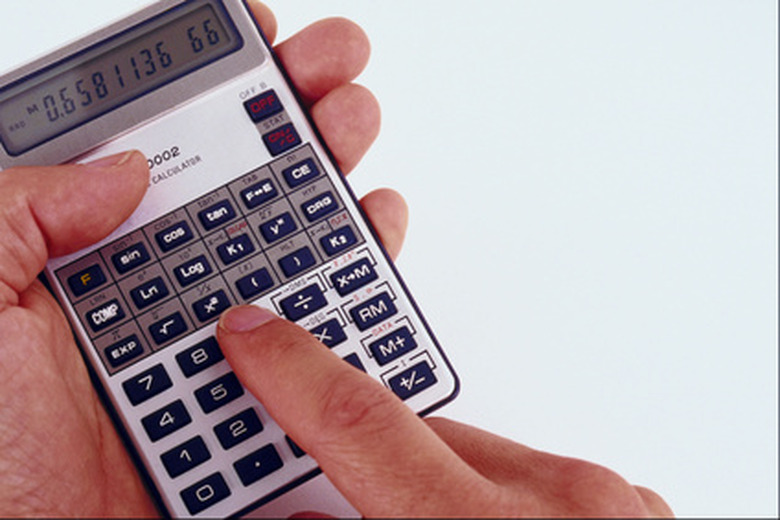How To Calculate Bond Enthalpy
When molecules are formed by the joining of atoms that form bonds, the process either requires an input of energy to create the bond or liberates energy as heat because the atoms in question "want" to bond. In either case, the system consisting of the reactant molecules and the product molecules undergoes an energy change, which in this context is called an enthalpy change.
Molecules, as you probably know, come in all sorts of "flavors," and the number of different bonds and bond types observed between various types of atoms (C**−C, C=C, C−H, N−**O, C=O and so on) results in a wide variety of bond enthalpies. The enthalpy change for a reaction can be calculated from the individual values of bond enthalpy in a simple arithmetic way.
What Is a Chemical Bond?
What Is a Chemical Bond?
Atoms typically do not "like" to exist on their own; most are cursed with arrangements of their electrons that leave them in less-than-optimal energy states. Only by sharing, donating or gaining electrons can most atoms attain a lower (i.e., preferable) energy state. (The noble gases, such as helium and neon, are notable exceptions.)
When atoms share electrons to create bonds, the resulting connection is called a covalent bond. Water (H2O) is one of many everyday examples of compounds with covalent bonds. On the other hand, when the electronegativity difference between atoms is sufficiently large, one atom in effect yanks an electron from the other, creating an ionic bond, as in table salt (sodium chloride, or NaCl).
Different kinds of bonds have different bond energies based on the number of electron pairs involved (two in a so-called single bond, four in a double bond and eight in a triple bond) and how the two atoms relate to each other in terms of electrical potential and other factors. The upshot is that individual bond energies, or **bond enthalpies,** have been experimentally determined,
What Is Bond Enthalpy?
What Is Bond Enthalpy?
Enthalpy is a quantity in thermodynamics describing the heat that is transferred during chemical reactions. As heat, it can be thought of as one of the many forms of energy in physical science (e.g., gravitational potential energy, kinetic energy, sonic energy and so on).
Bond enthalpy is the energy required to form or break a given bond. Its value can change between molecules, even for the same type of bond. For example, the bond energy of H2O's two O−H bonds is 464 kilojoules per mole (kJ/mol), but in methanol (CH3OH) the one O−H bond has an enthalpy of 427 kJ/mol.
The Bond Enthalpy Equations
The Bond Enthalpy Equations
The bond enthalpy Dx−y of a diatomic gas molecule XY is the enthalpy change for the process represented by the generic reaction:
**XY(g) → X(g) + Y(g)**
ΔH° (298 K) = Dx−y
Any bond enthalpy formula is given at 298 K by convention to standardize the equation. This is approximately room temperature, equal to 25 °C or 77 °F. In reality, the reaction above is most often hypothetical, as most molecules do not exist as monatomic gases at 298 K.
If you have a simple reaction between two molecules and know the bond enthalpies of the individual bonds, you can use the following relationship to calculate the total enthalpy change for the reaction. If it is negative, heat is released, and the reaction is exothermic; if positive, the reaction is endothermic (and will not proceed without the addition of energy).
**Hrxn=ΣΔHbroken+ ΣΔHmade **
Examples of Bond Enthalpy Problems
Examples of Bond Enthalpy Problems
Calculate the enthalpy of the reaction:
CO(g) + 2 H2(g) ⟶ CH3OH(g)
The enthalpy of the bonds in the molecule can be determined from the enthalpies of the individual bonds. For this, refer to a table such as the page given in the Resources.
You can see that there are a total of three bonds broken: The triple bond between C and O and the two H−H bonds. The total enthalpy is 1072 + 2(432) = 1,936 kJ.
The number of bonds formed is five: three C**−**H bonds, one C-O bond and one O−H bond. The total enthalpy of these bonds is 3(411 ) + 358 + 459 = 2,050 kJ.
Thus the total enthalpy change is 1,936 − 2,050 = −114 kJ. The negative sign shows that the reaction is exothermic, liberating rather than requiring energy to proceed.
Cite This Article
MLA
Beck, Kevin. "How To Calculate Bond Enthalpy" sciencing.com, https://www.sciencing.com/calculate-bond-enthalpy-7196351/. 1 March 2020.
APA
Beck, Kevin. (2020, March 1). How To Calculate Bond Enthalpy. sciencing.com. Retrieved from https://www.sciencing.com/calculate-bond-enthalpy-7196351/
Chicago
Beck, Kevin. How To Calculate Bond Enthalpy last modified March 24, 2022. https://www.sciencing.com/calculate-bond-enthalpy-7196351/
